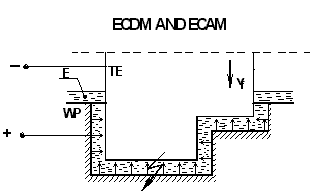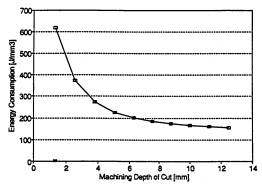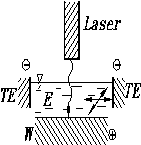Section 3. Pulsed ECM and Laser Assisted ECM
Pulsed ECM: Electrochemical Discharge(Arc) Machining (ECDM/ECAM)
ECM is an electrochemical dissolution process in which the tool is the cathod and the workpiece is the anode in an electrolytic cell. The most important ECM-based processes are ECM with continuous current(normal ECM), ECM with pulsed current(PECM), EC grinding and EC deburring. ECM occurs at high current density (greater than 200A/cm2), causing rapid dissolution of the anode. Electrochemical Machining (ECM) is characterized by high surface integrity, improved surface finish, high machining rate, and the absence of tool-electrode wear. ECM does not appreciably alter the material properties of the workpiece, nor does it impart residual thermal or mechanical stress as do manyu other NTM and traditional machining processes. But ECM is originally a difficult process to control. Die sinking ECM relied on an iteratie trial-and-error cycle of tool design and workpiece machining until a desired tolerance was reached.
As
compared with EDM, ECM has low accuracy of reproduction of the shape of the
tool electrode into the workpiece. On the other hand Electrical Discharge
Machining (EDM) can provide a high surface finish only with a low productivity,
and an increase in the machining rate results in a significantly increased
roughness and deeper damaged surface layer. However, a reduction in surface
roughness leads to increased tool wear. A combination of ECM with EDM in one
process in an electrolyte solution, which is termed ECDM, has shown to have
the benefits of both processes, provided that the parameters are properly
selected. Figure 8 illustrates the scheme of ECDM sinking process.
Under critical conditions(i.e.
at the critical voltage Ucr and the critical current density Icr),
the solution starts boiling and evaporating near one of the electrodes as
a result of intense electric heating. The electrochemical reactions assist
these processes. A gas-vapor layer is formed and sustains high resistance
in the gap. A
major fraction of the applied voltage drops in this layer. First, a local
electric breakdown of the layer occurs (sparking is observed) and, then, the
breakdown of the entire interelectrode gap occurs. Every such breakdown causes
evaporation and a local ejection of the metal into the aqueous medium, where
the metal is cooled, solidified, and carried away by the electrolyte flow.
The higher the energy of a single pulse, the larger the erosion cavity it
can produce, the higher the removal rate and the poorer the surface finish.
Under the operating conditions of ECDM, at each instant, only one breakdown
channel (very few, if not one) arises at the metal surface. The discharges
occur more frequantly, every time at a new site (every subsequent discharge
takes place near the previous one). As the electric breakdown is localized
and the metal erosion occurs at a micro region, the metal dissolves electrochemically
from the rest of the workpiece [1].

|
| Fig. 8 Scheme of ECDM/ECAM and CPS |
The
rates of material removal can be as much as five to fifty times greater than
ECM and EDM respectively. ECDM has been used in hole drilling, die sinking
[2], and cutting [3]. ECDM are especially effective when dealing with materials
with hgh strength and heat resistance. Machining capacity on the order 104
mm3/min, accuracy of 0.04-0.2 mm and surface roughness of Ra =
1.25-2.5 mm
can be obtained.
 |
 |
| Fig. 9ECDM with Rotating Electrode | Fig. 10 Specific energy consumption vs. Depth of cut |
One of the effective means of improving ECDM accuracy and smoothness is to impart a rotating movement to the profile–shaped electrode. The kinematics of the machining is analogous to milling, grinding or ECG. The scheme of ECDM with a rotating electrode ECDM-RE) is shown in Figure 9. The tool-electrode is connected to the negative polarity, while the workpiece is connected to the positive polarity of a pulse generator or continuous power supply of direct current. There is a gap between the electrodes through which electrolyte flow. During machining, the rotating tool-electrode is set at the depth of cut g0, while the workpiece moves with a feed rate Vf (Figure 7). In ECDM-RE process, the machining region is established in two zones: EC with electrochemical dissolution and electrical discharge zone ED. Electrical discharges in ED zone can be created by electrical breakdown of the vapor-gas layer as well as by instantaneous short-circuits between the electrodes. In both cases, the deciding factor is the appearance of vapor-gas layers resulting mainly from heating of the electrolyte. Due to electrical erosions on the machining surface, a large number of craters are formed in ED zone. These surface irregularities are subject of electrochemical smoothing by dissolution, roughness is reduced. Therefore better quality of machined surface and simultaneously larger Material Removal Rate in ECDM-RE than in ECM-RE or EDM are obtained. Energy consumption is reduced, energy consumption also decreases with the increasing machining feed rate Vf and the depth of cut g (Figure 10) [2,3].
Laser Asssited ECM
Laser irradiation can generate localized energy deposition in wide energy ranges with accurate position and energy level control. As mentioned in section 1, laser energy can increase the temperature of the metal surface while many chemical and physical process are sensitive to temperature variations. An attractive feature of laser enhanced processing is the ability to obtain maskless patterns during material deposition or dissolution, which can be conveniently controlled by the scanning path of the focused laser beam. Laser assisted chemical etching and ECM are good examples of the cross processes. In normal laser machining, the precision of machining is limited by the strong evaporation or melting, redeposition and thermal stress can hardly be avoided. While chemical processes has the advantage of burrless and stress-free processing. Chemical processes under normal conditions may be inefficient. Laser irradiation can be used to accelerate such processes.
Enhancements in plating, etching, and electrochemical dissolution result from photothermal mechanism rather than photochemical mechanism [4]. In addition to laser-enhanced electroplating and electro-etching, there are plating and etching processes that require no external electrical sources. For example, Laser-assisted etching (LAE) is a maskless photoreactive or thermal reactive process. The etching of ceramics, semiconducting materials, metals, and high polymers in an etchant can be enhanced substantially when laser irradiation is used. Ceramics can be etched at a rate of 200 mm/s in KOH solution when assisted by Nd-YAG laser beam. The method has been applied to the fabrication of superconductive ceramic or diamond membranes. Semiconducting devicies can be etched 10 to 100 times faster using laser assisted chemical etching than that with conventional procedures[5].
In
laser assisted ECM, the substrate is immersed in electrolyte, laser irradiates
the metal surface through the electrolyte(Figure 11). The laser irradiation
enhances localized dissolution/deposition of the material. The laser beam
accelarates the electrochemical reactions during non-destructive illumination
of the workpiece.
 |
|
| Fig.
11 Laser assisted ECM |
|
Laser irradiation can locally(on micron scale) accelerates the electrochemical process by tens of times [6-9]. With the relative motion between the laser beam and the workpiece, a required pattern can be easily realized. The wavelength of laser radiation should be chosen properly so that minimal energy is adsorbed by the electrolyte, . For this reason, the electrolyte layer should be as thin as possible.
Experiments
and computer simulations prove that laser assistance of ECM can increase material
removal rate and can make anodic dissolution localized, especially when passivation
occurs during electrochemical dissolution [9]. Fig. 12 shows the difference
in profiles between normal ECM and laser assisted ECM (LECM).
 |
|
Fig.
12 Machined profiles by normal ECM and ECM with laser assistance (LECM).
Material: NC6, electrolyte: 15% NH4NO3, i =
4.4 A/cm2U = 12 V [9]
|
References
[1] Davydov, A.,D., Kozak, J.:
Physico-Chemical Principles of Electrochemical Discharge Machining.
Elektronnaja Obrabotka Materialov (Surface Engineering and Applied Electrochemistry
edit.USA), 1991,pp.3-13.
[2]
De Silva, A., McGeough, J. A.:
The Production of Full Die shapes by ElectrochemicalArc/Electrochemical
Machining. Proceedings of the ISEM-9, Nagoya, 1989, pp.107-110.
[3]
Kozak, J., Prusak, M.:
Electrochemical Arc Cutting. Proceedings of the ISEM-9, Nagoya, 1989,
pp.103-106.
[4]
Von Gutfeld, R. J., Shepard, K. G.:
Electrochemical Microfabrication by Laser-Enhanced Photothermal Processes.
IBM Journal of Research and Development, vol. 42, No. 5, 1998, pp. 639-653
[5]
Fujimasa, I.:
Micromachines. A New Era in Mechanical Engineering. 1996,Oxford University
Press.
[6]
Datta M.:
Microfabrication by Electrochemical metal Removal. IBM Journal of Research
and Development, vol. 42, No. 5, 1998, pp. 655-669
[7]
Dikusar, A. I., Engelhardt, G. R.,Molin, A. N.:
Thermokinetic Phenomena in High Rate Electrode Processes. Shtintsa,
1989.
[8]
Davydov A., D.:
Laser Electrochemical Machining of Metals. Russian Journal of Electrochemistry,
Vol. 30, No.8, 1994, pp.871-881.
[9] Kozak J., Dabrowski L., Rozenek M., Zawora J.:
Investigations of the Effects of Laser Radiation on Electrochemical Shaping
Process. Transaction of WUT-New Technologies vol. 2, 1999, (in Polish)